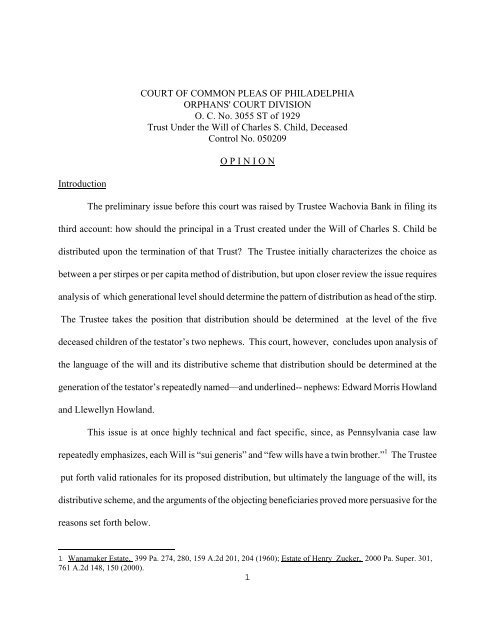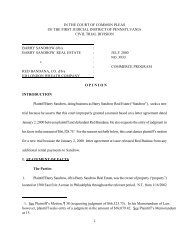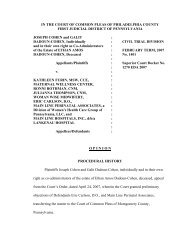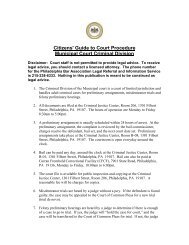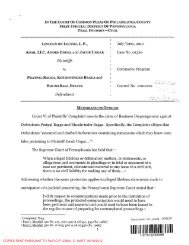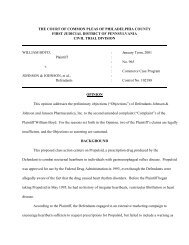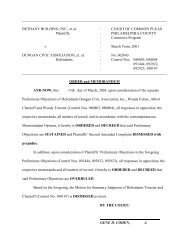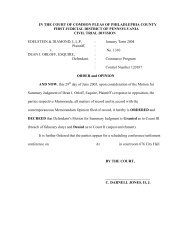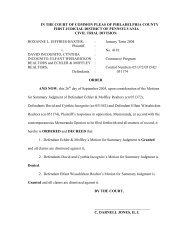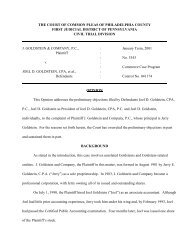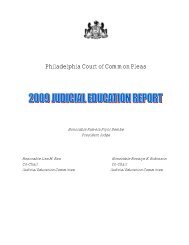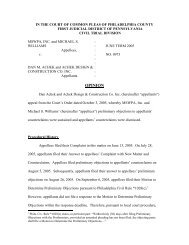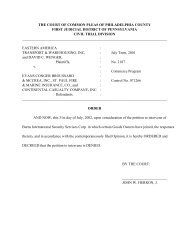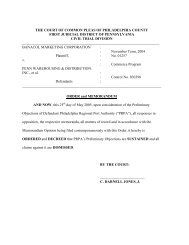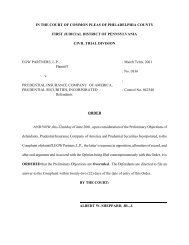1 COURT OF COMMON PLEAS OF PHILADELPHIA ORPHANS ...
1 COURT OF COMMON PLEAS OF PHILADELPHIA ORPHANS ...
1 COURT OF COMMON PLEAS OF PHILADELPHIA ORPHANS ...
You also want an ePaper? Increase the reach of your titles
YUMPU automatically turns print PDFs into web optimized ePapers that Google loves.
<strong>COURT</strong> <strong>OF</strong> <strong>COMMON</strong> <strong>PLEAS</strong> <strong>OF</strong> <strong>PHILADELPHIA</strong><br />
<strong>ORPHANS</strong>' <strong>COURT</strong> DIVISION<br />
O. C. No. 3055 ST of 1929<br />
Trust Under the Will of Charles S. Child, Deceased<br />
Control No. 050209<br />
O P I N I O N<br />
Introduction<br />
The preliminary issue before this court was raised by Trustee Wachovia Bank in filing its<br />
third account: how should the principal in a Trust created under the Will of Charles S. Child be<br />
distributed upon the termination of that Trust? The Trustee initially characterizes the choice as<br />
between a per stirpes or per capita method of distribution, but upon closer review the issue requires<br />
analysis of which generational level should determine the pattern of distribution as head of the stirp.<br />
The Trustee takes the position that distribution should be determined at the level of the five<br />
deceased children of the testator’s two nephews. This court, however, concludes upon analysis of<br />
the language of the will and its distributive scheme that distribution should be determined at the<br />
generation of the testator’s repeatedly named—and underlined-- nephews: Edward Morris Howland<br />
and Llewellyn Howland.<br />
This issue is at once highly technical and fact specific, since, as Pennsylvania case law<br />
repeatedly emphasizes, each Will is “sui generis” and “few wills have a twin brother.” 1 The Trustee<br />
put forth valid rationales for its proposed distribution, but ultimately the language of the will, its<br />
distributive scheme, and the arguments of the objecting beneficiaries proved more persuasive for the<br />
reasons set forth below.<br />
1 Wanamaker Estate, 399 Pa. 274, 280, 159 A.2d 201, 204 (1960); Estate of Henry Zucker, 2000 Pa. Super. 301,<br />
761 A.2d 148, 150 (2000).<br />
1
Background<br />
Charles S. Child died on February 15, 1929. Prior to his death, he executed a Will dated<br />
April 28, 1925 and two codicils dated April 24, 1928, under which he provided that the residue of<br />
his estate would be held in trust. Fidelity Trust Company was named as Executor and Trustee under<br />
the will. On March 30, 2005, Wachovia Bank, N.A., as Successor Trustee, filed its Third Account<br />
covering the period December 13, 1966 to February 15, 2005. According to the Account the balance<br />
of principal before distribution is $12,115,458.17.<br />
The account was scheduled for the May 2, 2005 Audit List. On April 29, 2005, Objections<br />
to the proposed distribution set forth in the Account were filed by some of the remainder<br />
beneficiaries of the trust: Edward M. Howland, Margaret Howland, Jonathan Howland, Peter<br />
Howland and Susan Howland Farrell (the “objectors”). A conference was scheduled, at which the<br />
parties agreed to a briefing schedule as to the distribution issue alone. Any issues as to Trustee<br />
commissions or legal fees and costs, 2 it was agreed, would await a ruling on this distribution issue.<br />
Trustee Wachovia Bank in its petition for adjudication and statement of proposed distribution<br />
(“petition”) notes that the Trust terminated in February 13, 2004, with the death of Llewellyn<br />
Howland, Jr. --the last of the children of the testator’s nephews born prior to the testator’s death.<br />
Wachovia raises as a question for adjudication whether the remaining principal of the trust should<br />
be divided into shares at the generation of the testator’s nephews—Edward Morris Howland and<br />
2 The beneficiaries of Llewellyn Howland who support the Trustee’s proposed distribution (hereinafter “Trustee<br />
Supporters”) nonetheless object to trustee commissions as well as legal fees and costs. See Objections and Trustee<br />
Supporters’ 7/22/2005 Memorandum at 4. These descendants of Llewellyn Howland include: Hope Hickok, Robert<br />
G. Potter, Jr., Hope Potter, Samuel Potter, Jr., Llewellyn Howland, III, Hope Howland Hale, Sarah H. Godfrey,<br />
2
Llewellyn Howland which it characterized as the “per stirpes method” or at the following<br />
generation, consisting of the five children of the those two nephews which it characterized as the<br />
“per capita method.” 3 The Trustee takes the position that principal should be awarded according to<br />
the per capita method with a division into five equal shares at the level of the nephews’ five children.<br />
The objecting beneficiaries disagree and contend that the trust principal should be divided<br />
at the level of the two nephews into two equal shares with one share represented by the testator’s<br />
nephew Llewellyn Howland and the other share represented by testator’s nephew Edward Morris<br />
Howland. The objectors emphasize that prior to the termination of the trust, the trust income had<br />
been distributed according to the pattern they now advocate for distribution of the principal: per<br />
stirpes beginning at the level of these two nephews. The Trustee’s proposed change in the pattern of<br />
distribution, the objectors assert, should not be approved. 4<br />
Legal Analysis<br />
The parties agree that in interpreting a will, the testator’s intent is “all-important.” If the<br />
language of the Will is clear, it should control and no rules of interpretation are necessary. England<br />
Estate, 414 Pa. 115, 118, 200 A.2d 897, 898 (1964). In analyzing a will certain guidelines are<br />
followed. It is thus well established that “(1) the testator’s intent is the polestar and must prevail;<br />
and (2) that his intent must be gathered from a “consideration of (1) all the language contained in the<br />
four corners of his will and (b) his scheme of distribution and (c) the circumstances surrounding him<br />
at the time he made his will and (d) the existing facts….” In Re: Trust Under Will of Barclay<br />
Waldo Howland, Jr., Charles C. Howland, Thomas B. Howland, Kinnaird Howland and Katherine Sue Means.<br />
3 See Rider to Question 13 of Petition for Adjudication.<br />
4 See 4/29/2005 Objections of Edward Howland, Margaret Howland, Jonathan Howland, Peter Howland and<br />
Susan Howland Farrell.<br />
3
McFadden, Deceased, 705 A.2d 930, 931 (Pa. Super. 1998). The same principles apply to both<br />
trusts and wills. In re Trust Estate of Pleet, 488 Pa. 60, 66, 410 A.2d 1224, 1228 (1980).<br />
A. The Express Words of Charles Child’s Will Convey the Intent that His Two Nephews,<br />
Whose Specific Names Are Set Forth and Underlined, Should Be the Defining Point<br />
For the Division and Subsequent Distribution of Income and Then Principal at the<br />
Termination of the Trust<br />
The starting point for resolution of the issues raised by the Trustee’s account must be the<br />
terms of the Will of Charles Child. In Article THIRD of his Will, Charles Child set forth the<br />
following Trust provisions:<br />
THIRD: All the rest, residue and remainder of my estate, real, personal and mixed, of<br />
whatsoever nature and wheresoever situtate, I give, devise and bequeath unto my Executor,<br />
hereinafter named, to hold the same In Trust until the death of the survivor of my two sisters,<br />
Mary B. Child and Caroline T. Howland, and my two nephews, Llewellyn Howland and<br />
Edward Morris Howland, and such of the children of my said nephews as shall be living at<br />
the time of my death, and during the continuance of said trust to distribute the net income<br />
therefrom quarterly as follows:<br />
Unto my sister, Mary B. Child, one-half thereof for and during the full term of her natural<br />
life.<br />
Unto my sister, Caroline T. Howland, one-half thereof for and during the full term of her<br />
natural life.<br />
And upon the death of each of my said sisters to pay the share of income formerly<br />
received by my sister so dying unto my nephews, Llewellyn Howland and Edward Morris<br />
Howland, in equal shares for and during the full terms of their respective natural lives, and<br />
upon the death of each of my said nephews to pay such share of the said income as my said<br />
nephew would have received if living unto such of his children and issue of deceased<br />
children as may be living at each quarterly period of distribution, equally, per stirpes.<br />
If at any quarterly period of distribution there shall not be living any of the children or<br />
issue of deceased children of either of my nephews so deceased then to pay the said share of<br />
income unto the widow of my said nephew for and during the term of her natural life. If,<br />
however, she shall not then be living, or if she shall be living then upon her subsequent<br />
4
death, the said share of income shall be paid to my other nephew, his issue or widow, as the<br />
case may be and as is herein provided for his share.<br />
And upon the termination of the Trust as aforesaid to transfer, assign and pay over the<br />
principal of my residuary estate unto such of the children and issue of deceased children of<br />
my said nephews, Llewellyn Howland and Edward Morris Howland, as may be living at that<br />
time equally, absolutely, per stirpes, subject, however, to the life estates hereinbefore<br />
provided for the widows of my said nephews.<br />
Article THIRD, Will of Charles Child, April 28, 1925<br />
Charles Child thus provided in his Will that the residue of his estate would be held in trust<br />
until the death of his two sisters, Mary Child and Caroline Howland, his two nephews, Llewellyn<br />
Howland and Edward Morris Howland, and those children of his two nephews who “shall be living<br />
at the time of” his “death.” While the trust was in effect, Article THIRD of the Child Will provided<br />
that income should first be distributed to the testator’s sisters, Mary Child and Caroline Howland,<br />
but upon each of their deaths the income was to be paid “unto my nephews Llewellyn Howland and<br />
Edward Morris Howland, in equal shares” throughout their lives. It further provides that “upon the<br />
death of each of my said nephews to pay such share of the said income as my said nephew would<br />
have received if living unto such of his children and issue of deceased children as may be living at<br />
each quarterly period of distribution, equally, per stirpes.” 5 Despite the immediate juxtaposition of<br />
the words “equally” and “per stirpes,” the parties agree that under the terms of the Will, the income<br />
of the trust was properly distributed per stirpes through the two equally treated nephews to their<br />
heirs. 6<br />
5 Article THIRD, Will of Charles Child, April 28, 1925.<br />
6 Objectors 6/30/2005 Memorandum at 2; Trustee Supporters 7/22/2005 Memorandum at 7-8. Neither Llewellyn<br />
nor Edward had any additional children after their uncle’s death. Edward had two sons: George, who died in 1983<br />
and Jonathan, who died in 1971. Llewellyn had 3 children: Priscilla, who died in 1980; Llewellyn, who died in<br />
5
However, with the termination of the trust at the death of the nephews’ last living child<br />
Llewellyn Howland, Jr. on February 13, 2004, the Trustee now proposes that the pattern of<br />
distribution should change. It proposes that the remaining principal should be divided into five equal<br />
parts representing the nephews’ five children who were deceased when the Trust terminated. Each<br />
of these one fifth shares, the trustee suggests, should then be distributed per stirpes among that<br />
child’s descendants. 7<br />
The objectors disagree. They assert that distribution of principal, like<br />
distribution of income, should be determined at the generational level of the two nephews, who<br />
were specifically named in Article THIRD of the Will. Under this scheme, the principal would be<br />
divided into two equal shares at that level. One share of principal would then be distributed per<br />
stirpes to the descendants of Child’s nephew Llewellyn Howland and the other share would be<br />
distributed per stirpes to the descendants’ of Child’s nephew Edward Morris Howland. 8<br />
The objectors’ position is supported both by the language of Article THIRD of the Child<br />
Will, and by its distributive scheme as defined in the context of the trust’s termination. Clearly, in<br />
resolving this dispute, the language of Article THIRD as a whole is relevant. See, e.g. Wanamaker<br />
Estate, 399 Pa. 274, 279, 159 A.2d 201, 204 (1960)(the testator’s intention “must be ascertained<br />
from a consideration of the entire will, including its scheme of distribution as well as its language”).<br />
In outlining the distribution of principal, Article THIRD once again focuses on the two specifically<br />
named and underlined nephews as the defining point for dividing the principal. It thus provides that<br />
upon the termination of the trust, the principal shall be paid “unto such of the children and issue of<br />
2004; and Waldo, who died in 1998. See Objectors’ 6/30/2005 Memorandum at 3 & Ex. B; Trustee Supporters<br />
7/22/2005 Memorandum at 3.<br />
7 See Trustee Supporters 7/22/2005 Memorandum at 2-3. This Memorandum presents a chart of its proposed<br />
distribution.<br />
6
deceased children of my said nephews, Llewellyn Howland and Edward Morris Howland, as may<br />
be living at that time, equally, absolutely, per stirpes, subject, however, to the life estates<br />
hereinbefore provided for the widow of my said nephews.” As was the case with the distribution of<br />
income, the two nephews are named and underlined. The recipients of the principal are named<br />
solely in terms of their relationship to the nephews rather than in terms of their relationship to the<br />
testator, thereby underscoring their significance as the defining points for principal distribution.<br />
The testator’s definition of when the trust terminates likewise underscores the definitive<br />
role of his two nephews in determining subsequent distributions, whether of income or principal.<br />
The Will provides that the trust terminates at the death of the Testator’s two sisters, two nephews<br />
“Llewellyn Howland and Edward Morris Howland,” and at the death of “such of the children of my<br />
said nephews as shall be living at the time of my death.” The nephews were from the same<br />
generation and thus represented a distinct, clearly defined class. Their children were of the next<br />
generation, but the Will did not provide that the Trust would terminate when all members of that<br />
generation died; rather, it provides that it would terminate at the death of “such of the children of my<br />
said nephews as shall be living at the time of” the testator’s death. The generation of the nephew’s<br />
children, therefore, was not defined in the Will as a discrete class intended to receive principal at the<br />
termination of the trust. 9<br />
Nor was it intended as a class for defining subsequent distributions of<br />
principal. The two nephews, Llewellyn Howard and Edward Morris Howland, in contrast, as a<br />
generation represented a discrete, complete class that was clearly defined in the Will for the<br />
8 6/30/2005 Objectors’ Memorandum at 3.<br />
9 As a matter of fact, no additional children were born to the nephews after Child’s death. Nonetheless, it is his<br />
intent as expressed in his Will that must control. By defining the duration of the Trust in terms of “such children of<br />
my said nephews as shall be living at the time of my death,” Child’s Will did not envision that generation—as<br />
7
purposes of determining subsequent distributions. The Will, for instance, provides that the principal<br />
be paid to the “children and issue of deceased children of my said nephews, Llewellyn Howland and<br />
Edward Morris Howland, as may be living at that time equally, absolutely, per stirpes…” Once<br />
again, it is the generation of the nephews that is the clear, defining point for the distribution, in this<br />
case, of principal. As with the distribution of income, this provision calls for an equal and per<br />
stirpes distribution of principal between the families of the testator’s two named nephews.<br />
Support for this conclusion can be found in In re: Trust Under Will of Barclay McFadden,<br />
705 A.2d 930 (Pa. Super. 1998). In McFadden, the Superior Court also analyzed a Trust created by a<br />
Will that provided that the Trust would terminate “twenty-one years after the death of the last<br />
survivor of all of my children and grandchildren born in my lifetime.” At the time of termination,<br />
therefore, the McFadden Will provided that the generation of the testator’s children would have<br />
died, while only the grandchildren born in the lifetime of the testator would have died. The Will<br />
provided that at termination, “the whole of principal of my residuary estate shall be paid, assigned,<br />
transferred and set over to my descendants then living in equal shares, per stirpes upon the principle<br />
of representation.” McFadden, 705 A.2d at 931.<br />
The Superior Court approved the Orphans’ Court conclusion that the principal should be<br />
divided into two parts defined at the generational level of the testator’s two deceased children.<br />
Consequently, the one child of the testator’s daughter in McFadden received half of the principal<br />
while the six children of the testator’s son divided the other half of the principal among themselves.<br />
In explaining its conclusion, the McFadden court noted that in setting forth the distribution of<br />
principal upon the termination of the Trust, “the designation ‘equal shares’ does not stand alone; but<br />
whole-- as a defining class of the trust for the purposes of distributing principal.<br />
8
ather it is modified by the phrase ‘per stirpes upon the principle of representation.’’ McFadden, 705<br />
A.2d at 931-32. Equality was thus to apply between the lines of distribution, in this case defined by<br />
the testator’s two children. The Pennsylvania Supreme Court in Wanamaker Estate, 399 Pa. 274,<br />
283, 159 A.2d 201, 205 (1960) has likewise observed that where a will provides for distribution of<br />
principal “to and among the heirs of my children, then living in equal shares” the testator intended a<br />
per stirpes distribution, noting that the words “equally between them” may apply both to a division<br />
among classes as well as to a division among individuals.<br />
The beneficiaries who support the Trustee’s proposed distribution acknowledge that “the<br />
issue is more accurately characterized as a disagreement about the generation that marks the ‘heads<br />
of the stirps,’ which is the generation at which equal division first occurs.” In their view, however,<br />
the Trustee properly proposes “a five share interpretation under which the equal division occurs at<br />
the generation of the five children of the nephews.” 10<br />
To support the Trustee’s position, they<br />
invoke, inter alia, Abele Estate, 34 Pa. D & C 2d 273 (Phila.Cty. 1963).<br />
The Abele Estate, however, is factually distinguishable. 11<br />
The testator in Abele created a<br />
Trust and provided for the equal distribution of income among his brothers and sisters. This Trust<br />
terminated at the death of all of the brothers and sisters—or, the entire class. Upon the death of all<br />
members of this class, principal was to be distributed “unto such of the children and issue of<br />
deceased children of my said brothers and sisters as may be living at the time fixed for the said<br />
10 Trustee Supporters 7/22/2005 Memorandum at 4.<br />
11 Interestingly, Pennsylvania courts have repeatedly cautioned that due to the “sui generis” and highly personal<br />
nature of a will, “precedents are often of little value in interpreting a will.” Estate of Henry Zucker, 2000 Pa. Super.<br />
301, 761 A.2d 148, 150 (2000). See also Estate of Pleet, 488 Pa. 60, 71, 410 A.2d 1224, 1230 (1980)(“Prior cases<br />
and scholarly works are of limited use, however, because in every case the overriding consideration is the intent of<br />
the testator and settlor”). This intent can be gleaned not just from discrete words, but, of necessity, from complex<br />
patterns of distribution as well.<br />
9
distribution, equally, absolutely, per stirpes.” 12 Under these facts, Judge Shoyer concluded that an<br />
equal, per capita distribution was appropriate to the members of the class “intended primarily to<br />
receive principal.” 13<br />
In Abele, the court approved a per capita distribution to the entire class<br />
consisting of the testator’s nieces and nephews--the generation immediately surviving the death of<br />
the class of testator’s brothers and sisters. As these facts suggest, Abele offers only limited<br />
guidance on determining the head of the stirps in the Child Trust because in Abele<br />
the trust<br />
terminated with the demise of an entire class or generation. Hence, to determine the head of the<br />
stirp, the focus was on only two-- discretely defined-- generations.<br />
That is very different from the relationships and distributive pattern in the instant Child Will.<br />
First, the Trust created under the Child Will did not clearly terminate with the death of an entire<br />
class, as previously discussed. Second, at the termination of the Trust, principal was to go to the<br />
“children or deceased children of my said nephews, Llewellyn Howland and Edward Morris<br />
Howland”, but as the Trustee supporters concede, these five children of the nephews had all died by<br />
the time the trust terminated. 14 Nonetheless, the Trustee proposes using this class of five deceased<br />
children of the nephews as the reference point for dividing the trust principal. This is clearly<br />
distinguishable from the pattern of distribution in Abele, which recognized an equal per capita<br />
distribution among the surviving—living-- class that would actually receive the principal.<br />
Moreover, the express terms of the Child Will are distinguishable from those in Abele. In his will,<br />
Charles Child expressed the intent that the nephews, rather than their children, should be the “head<br />
of the stripes” when he repeatedly underlined their names and defined the other heirs in terms of<br />
12 Abele Estate, 34 Pa. D & C 2d 273, 274 (Phila. Cty. 1963).<br />
13 Abele Estate, 34 Pa.D. & C 2d at 280.<br />
10
their relationship to these specifically named nephews.<br />
The other case cited by the Trustee’s supporters, England Estate, 414 Pa. 115, 200 A.2d 897<br />
(1964) is also distinguishable. The testator in the England Estate created a Trust that terminated at<br />
the death of his last surviving child. Upon the termination of the Trust, the relevant terms of the<br />
Will provided for the distribution of principal “equally amongst the children of my children, who<br />
shall then be living, and the issue of such of them as my be deceased, per stirpes, absolutely and in<br />
fee.” 15<br />
The clear import of these words, as the Pennsylvania Supreme Court concluded, was that<br />
there be an equal per capita distribution of principal to the children of the testator’s children, with<br />
any deceased child of a child, to receive a per stirpal share. The England Estate, therefore, did not<br />
raise the prickly issue of where the head of the stirpes should be found where an entire intervening<br />
class of potential principal distributees is deceased. Rather, the division in the England Estate -- as<br />
in Abele -- occurs with the class that immediately receives the principal. There was no need to<br />
choose among two deceased classes of heirs as there is in the instant Child case. Hence, this<br />
precedent likewise offers little guidance.<br />
But even if the distributive schemes were analogous, the facts of the England Estate are still<br />
distinguishable because of the relentless emphasis in the Child Will on the testator’s two nephews<br />
as defining the pattern of distribution. Not only were these two nephews repeatedly named, but<br />
those names were underlined again and again—to serve as a defining point for the distribution first<br />
of income, then of principal to their heirs.<br />
B Where the Income of the Trust Created Under the Will of Charles Child Was<br />
Distributed Per Stirpes Through the Families of the Two Nephews, the Principal Should<br />
14 Trustee Supporters 7/22/2005 Memorandum at 3 (family chart).<br />
15 England Estate, 414 Pa. 115, 200 A.2d 897, 898 (1964).<br />
11
Likewise Be Distributed through Those Two Families in the Absence of Clear Language<br />
to the Contrary<br />
There is another reason why principal should be distributed per stirpes through the two<br />
family lines defined by the testator’s two nephews. Before the Trust created under the Child Will<br />
terminated, income had been distributed according to a per stirpes pattern between the familial lines<br />
of the testator’s two nephews. All of the parties agree that this distribution was proper. 16 The<br />
objectors argue that this prior distribution of income is relevant to determining the proper<br />
distribution of principal upon termination of the Trust and invoke both McFadden and the Estate of<br />
Wanamaker. These cases support the proposition that a change from a per stirpes to a per capita<br />
distribution of income to principal at the termination of a trust must reflect the clear intent of the<br />
settlor.<br />
In McFadden, for instance, the Superior Court emphasized that “because the income from<br />
the trust had been distributed through the family branches of the respective parents of appellants and<br />
appellee for the life of the trust, ….and because no intent was clearly expressed in the will to change<br />
the distribution scheme from per stirpes to per capita at the termination of the trust, the testator’s<br />
intent provides for distribution of the principal in the same manner as the distribution of income had<br />
been accomplished.” McFadden, 705 A.2d at 932. Likewise, in Wanamaker Estate, the<br />
Pennsylvania Supreme Court emphasized that the testator’s intent to change the pattern of<br />
distribution at the termination of a trust from a prior per stirpes distribution of income should be<br />
16 As the beneficiaries supporting the Trustee’s position state: “In fact, there is no dispute about the application of<br />
these income provisions, and there never has been a dispute about these provisions.” Trustee Supporters 7/22/2005<br />
Memorandum at 7.<br />
12
clearly expressed. 17<br />
Otherwise, the Wanamaker court observed, the following anomaly might<br />
occur:<br />
It is unusual for a testator to intend and direct a per stirpes distribution of income among a<br />
specified class, to-wit grandchildren, and a per capita distribution of principal among the<br />
same class, to-wit grandchildren, with the result that the same grandchildren would receive a<br />
per stirpes share of income on Tuesday, but on Wednesday (the next day when the youngest<br />
heir or grandchild reached 21 years of age) would receive a per capita share of principal. It<br />
that was the testator’s intent, it should be clearly expressed, as it was in the other trusts.<br />
Wanamaker Estate, 399 Pa at 281, 159 A.2d at 204.<br />
In Article THIRD of Charles Child’s Will there was no such clear intent to impose a different<br />
pattern of distribution for principal and income. Instead, in both instances, the testator underscored<br />
that his two nephews—whose names were specifically set forth and underlined—should be the<br />
reference point for dividing the equal familial shares, first of income and then of principal.<br />
Finally, when asked to determine which generation in family was the “head of the stirpes”<br />
for purposes of distributing the principal of a terminated Trust, the Pennsylvania Supreme Court in<br />
Trust Estate of Pleet, 488 Pa. 60, 410 A.2d 1224 (1980) underscored the significance of the previous<br />
pattern of distributing Trust income. It cited approvingly the following Comment j from the<br />
Restatement of Property, Section 301 (1940):<br />
…if the members of the class are of two or more families and the parent of each of these<br />
families is given a prior life interest in an equal share in the subject matter of the class gift,<br />
this fact tends to establish that those class members who are the children of one life tenant<br />
are to take only that share in which the parent life tenant had his interest.<br />
Estate of Pleet, 488 Pa. at 72, 410 A.2d at 1231 (quoting Restatement of Property § 301,<br />
Comment j).<br />
This analysis, likewise, supports the conclusion that the Trust principal should be divided<br />
into two equal parts at the level of the testator’s two nephews.<br />
17 Wanamaker Estate, 399 Pa. at 281, 159 A.2d at 204.<br />
13
Conclusion<br />
For all of these reasons, this court concludes with the termination of the Trust, the principal<br />
should be distributed per stirpes though the families of Llewellyn Howland and Edward Morris<br />
Howland, Testator’s nephews. The Trustee should also make whatever adjustments are necessary as<br />
to the distribution of income and principal to the beneficiaries as of February 13, 2004, when the<br />
Trust terminated with the death of Llewellyn Howland, Jr. In reaching this conclusion, it must be<br />
emphasized that the issues raised were technical and highly fact specific, since it was the precise<br />
words and intent of the Charles Child Will that control. The precedent, moreover, was not clear cut,<br />
since even the opinions in McFadden and Wanamaker Estate prompted vigorous dissents that would<br />
have reached a contrary conclusion. The Accountant is hereby ordered to file a revised statement of<br />
proposed distribution consistent with this opinion.<br />
Date: ___________<br />
BY THE <strong>COURT</strong>:<br />
_______________<br />
John W. Herron, J.<br />
14


